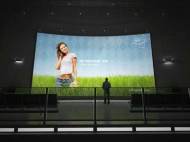Prysm TD1 Laser Phosphor Display plunges competition?
 A company from California named Prysm has presented their high definition television with a Laser Phosphor Display (LPD) based on their patented method of using lasers reflected off a bank of mirrors to excite pixels on the television screen in a similar way to cathode ray tubes. Aside the high image quality and wide viewing angle, the folks from Prysm claim LPD’s consume up to 75 percent less power than other display technologies on the market.
A company from California named Prysm has presented their high definition television with a Laser Phosphor Display (LPD) based on their patented method of using lasers reflected off a bank of mirrors to excite pixels on the television screen in a similar way to cathode ray tubes. Aside the high image quality and wide viewing angle, the folks from Prysm claim LPD’s consume up to 75 percent less power than other display technologies on the market.
The first generation of the LPD (also called the TD1) consists of a rectangular glass screen 63 centimeters in the diagonal (25 inches). Tiny patterns of phosphors are layered on the inside surface of the glass (or polymer), and these emit red, green or blue light when excited by a soft UV laser, to produce brilliant, high quality images. Since the phosphors are extremely close to the surface no image filtering is needed. The display can also be modified to suit specific viewing needs by using special coatings or substrates.
The solid-state laser are mounted behind the screen and point up at bank of minute, rapidly moving mirrors. The mirrors reflect the laser light across the screen to produce the necessary number of image lines and create the picture. The resultant images have no motion blur or flicker. The processor managing the laser varies the light intensity and turns the laser on and off, which means that when the display is dark the lasers are turned off to further reduce power consumption and increase the lifespan of the display.
The described mechanism unfortunately influenced the design, making the display that is currently 36 centimeters thick. However, according to its inventors, it has a greatly reduced power consumption – a quarter that of LCDs and only one tenth of plasma televisions. The sets can be built with existing technology and there is no requirement for clean rooms in the manufacture of the screens, which considerably cuts the expense.
The TD1 does not suffer the problem of low brightness, which is suffered by rear projection sets. It also has the advantage that the displays are highly configurable and can be stacked seamlessly to create large high-resolution video walls of almost any size or shape. The display has a brightness of 800nits, an optical seam of .25mm, and the viewing angle is almost 180˚. The fast response time of 240 Hz and the 1.6 mm dot pitch also both exceed competing technologies such as LED.
Powered by LPD’s solid-state components, the display solution offers an internal health monitor and auto-calibration system for 24/7 continuous operation and stable performance over the life of the application. However, it’s a question will the whole mechanism withstand the test of time and long-term usage.
Folks from Prysm stated they are dedicated to what they call “ecovative” technology – technology that is eco-friendly throughout its manufacture. Aside its greatly reduced power consumption, the TD1 does not contain toxic components, has no consumables, and generates little heat. They also claim their HDTV television will be competitive with LCD and plasma televisions within three to five years.









Leave your response!